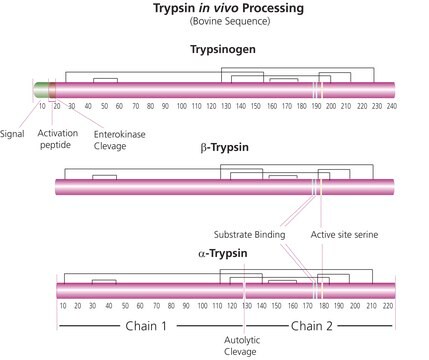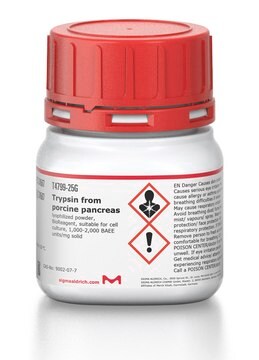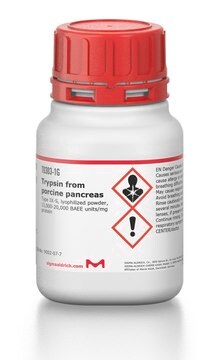T1426
Trypsin from bovine pancreas
TPCK Treated, essentially salt-free, lyophilized powder, ≥10,000 BAEE units/mg protein
Recommended Products
biological source
bovine pancreas
grade
Proteomics Grade
form
essentially salt-free, lyophilized powder
specific activity
≥10,000 BAEE units/mg protein
mol wt
23.8 kDa
solubility
hydrochloric acid: soluble 1 mM
application(s)
diagnostic assay manufacturing
foreign activity
Chymotrypsin ≤0.1 BTEE units/mg protein
storage temp.
−20°C
Looking for similar products? Visit Product Comparison Guide
Related Categories
Application
Biochem/physiol Actions
Serine protease inhibitors, including DFP, TLCK, APMSF, AEBSEF, and aprotinin, amongst others, will inhibit Trypsin.
Components
Caution
Unit Definition
Preparation Note
It is also TPCK-treated and dialyzed. Treatment with L-1-Tosylamide-2-phenylethyl chloromethyl ketone (TPCK) reduces the chymotrypsin activity which is usually present in trypsin.
inhibitor
substrate
Signal Word
Danger
Hazard Statements
Precautionary Statements
Hazard Classifications
Eye Irrit. 2 - Resp. Sens. 1 - Skin Irrit. 2 - STOT SE 3
Target Organs
Respiratory system
Storage Class Code
11 - Combustible Solids
WGK
WGK 1
Personal Protective Equipment
Regulatory Information
Certificates of Analysis (COA)
Search for Certificates of Analysis (COA) by entering the products Lot/Batch Number. Lot and Batch Numbers can be found on a product’s label following the words ‘Lot’ or ‘Batch’.
Already Own This Product?
Documents related to the products that you have purchased in the past have been gathered in the Document Library for your convenience.
Difficulty Finding Your Product Or Lot/Batch Number?
How to Find the Product Number
Product numbers are combined with Pack Sizes/Quantity when displayed on the website (example: T1503-25G). Please make sure you enter ONLY the product number in the Product Number field (example: T1503).
Example:
Additional examples:
705578-5MG-PW
PL860-CGA/SHF-1EA
MMYOMAG-74K-13
1000309185
enter as 1.000309185)
Having trouble? Feel free to contact Technical Service for assistance.
How to Find a Lot/Batch Number for COA
Lot and Batch Numbers can be found on a product's label following the words 'Lot' or 'Batch'.
Aldrich Products
For a lot number such as TO09019TO, enter it as 09019TO (without the first two letters 'TO').
For a lot number with a filling-code such as 05427ES-021, enter it as 05427ES (without the filling-code '-021').
For a lot number with a filling-code such as STBB0728K9, enter it as STBB0728 without the filling-code 'K9'.
Not Finding What You Are Looking For?
In some cases, a COA may not be available online. If your search was unable to find the COA you can request one.
Which document(s) contains shelf-life or expiration date information for a given product?
If available for a given product, the recommended re-test date or the expiration date can be found on the Certificate of Analysis.
How do I get lot-specific information or a Certificate of Analysis?
The lot specific COA document can be found by entering the lot number above under the "Documents" section.
What is Product T1426, Trypsin from bovine pancreas, soluble in, and how do you recommend storing solutions?
Trypsin is soluble in 1 mM hydrochloric acid (pH approximately 3). It is also surprisingly stable in 1 mM HCl. Solutions are stable for approximately 1 year when aliquoted and stored at -20°C. The presence of Ca2+ (20 mM) will also retard trypsin's ability to autodigest, and will therefore help to maintain the stability of the trypsin in solution.
How much of Product T1426, Trypsin from bovine pancreas, should I use to digest my peptide?
For trypsin digestion of peptides, use a ratio (w:w) of about 1:100 to 1:20 for trypsin:peptide. Trypsin preparations usually contain some contaminating chymotrypsin and this should be inhibited with N-tosyl-L-phenylalanyl chloromethyl ketone (TPCK). Product No. T1426 has already been treated with TPCK, so it does not need to be further treated.
What is the extinction coefficient for Product T1426, Trypsin from bovine pancreas?
Various values have been reported in the literature for the extinction coefficient of bovine pancreatic trypsin. The E1%(280) values have ranged from 12.9 - 15.4. When we assay the protein content of Product No. T1426 in our labs here at Sigma, we use a value of 14.4.
Does Product T1426, Trypsin from bovine pancreas, work for in-gel digestions?
For in-gel digestions, we actually recommend using a methylated trypsin. Product No. T6567 is Trypsin from porcine pancreas, proteomics grade, dimethylated. For product T6567, the lysine residues of proteomics grade trypsin have been reductively methylated, resulting in a product that is resistant to autolysis. The T6567 has also been treated with TPCK to remove chymotryptic activity, further purified through affinity chromatography, and lyophilized. This results in an enzyme that gives highly specific cleavage.
How do I find price and availability?
There are several ways to find pricing and availability for our products. Once you log onto our website, you will find the price and availability displayed on the product detail page. You can contact any of our Customer Sales and Service offices to receive a quote. USA customers: 1-800-325-3010 or view local office numbers.
What is the Department of Transportation shipping information for this product?
Transportation information can be found in Section 14 of the product's (M)SDS.To access the shipping information for this material, use the link on the product detail page for the product.
My question is not addressed here, how can I contact Technical Service for assistance?
Ask a Scientist here.
Protocols
This procedure is for products with a specification for Trypsin activity using Na-Benzoyl-L-arginine ethyl ester (BAEE) as a substrate. The procedure is a continuous spectrophotometric rate determination (A253, Light path = 1 cm).
Our team of scientists has experience in all areas of research including Life Science, Material Science, Chemical Synthesis, Chromatography, Analytical and many others.
Contact Technical Service





